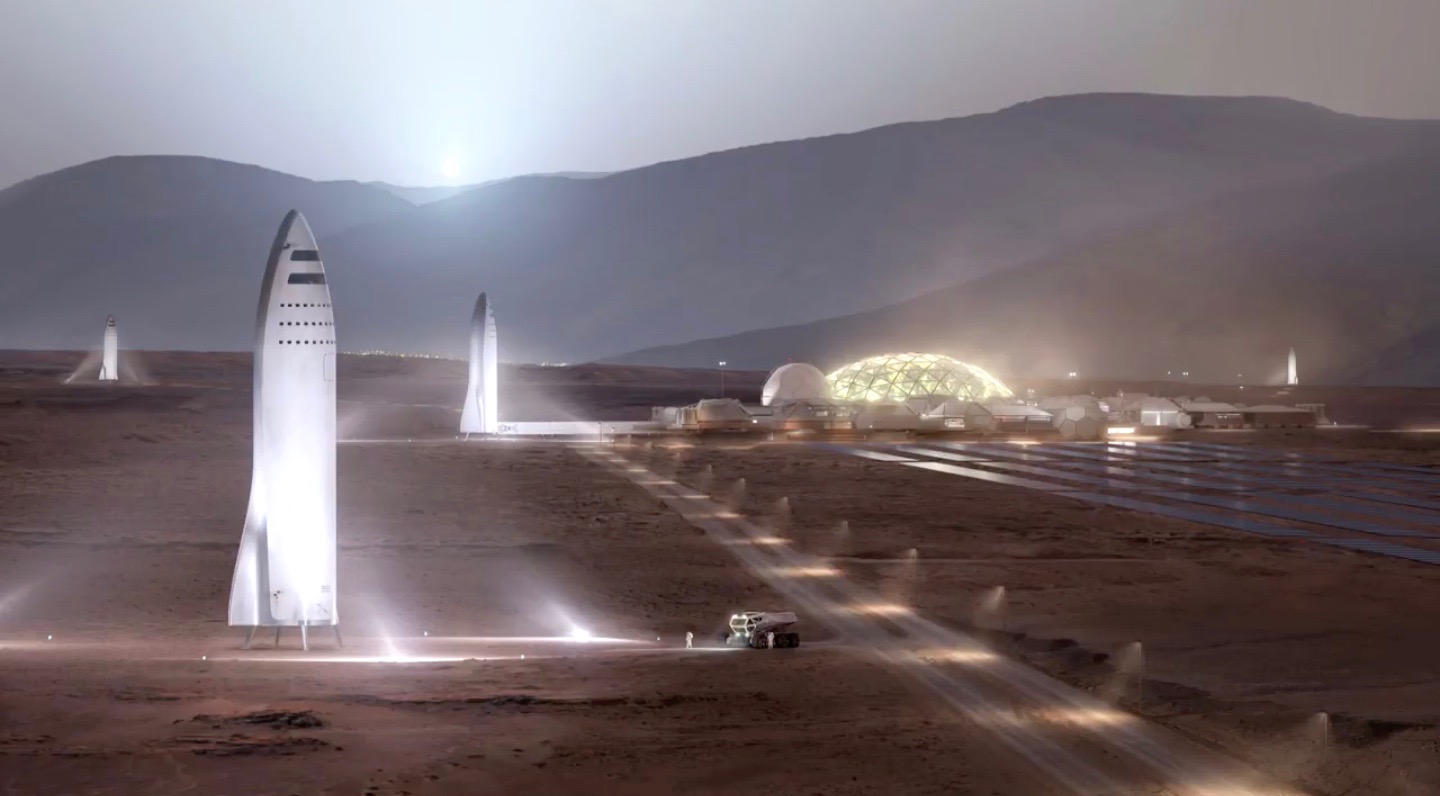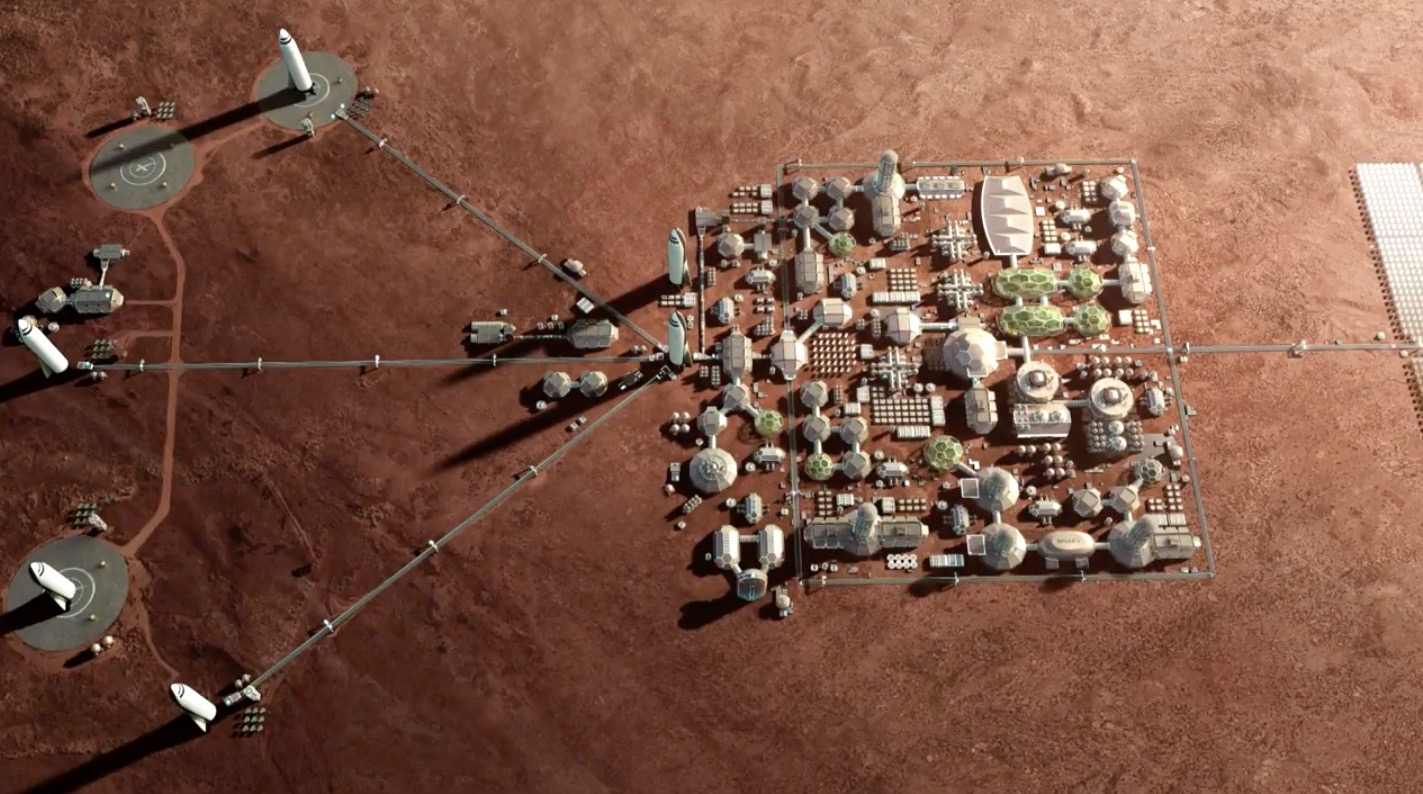Those are just two of the highlights of the company's current Mars-colonization plan, which SpaceX founder and CEO Elon Musk unveiled early Friday morning EDT (Sept. 29) at the 68th International Astronautical Congress (IAC) in Adelaide, Australia.
Musk's talk — which took place Friday afternoon local Adelaide time — served to update the architecture the billionaire entrepreneur revealed at last year's IAC, in Guadalajara, Mexico. That previous presentation introduced a huge, reusable rocket-spaceship combo called the Interplanetary Transport System (ITS), which Musk envisioned helping to establish a million-person city on Mars within the next 50 to 100 years. [The BFR: SpaceX's Mars-Colonization Architecture in Images]
As Musk described it last year, the roughly 40-foot-wide (12 meters) ITS booster would feature 42 Raptor engines. It would launch the spaceship to Earth orbit, then come back down to its pad for a pinpoint landing — and another flight in quick succession. The spaceship, meanwhile, would be fueled in orbit by a tanker (which would also be launched by an ITS booster).
The ITS spaceships would linger in orbit until the time was right to depart for Mars, when they would do so en masse. (Such windows come along once every 26 months.) Each ship would be capable of carrying about 100 people to the Red Planet; after landing there and offloading their cargo and passengers, the ships would top up their tanks on the Martian surface with locally produced propellant (methane and oxygen) and then launch back to Earth.

The new plan retains this same basic idea, but with some important tweaks. For example, the rocket has been scaled back a bit; it will now be about 30 feet (9 wide) and sport "just" 31 Raptor engines. (For comparison, the first stage of SpaceX's in-service Falcon 9 rocket has nine Merlin engines.) And the name "ITS" seems to be out: During Friday's talk, Musk repeatedly referred to the system by the "code name" BFR, which is short for Big F***ing Rocket.
But the most important change has to do with the system's affordability, Musk said Friday.
"In last year's presentation, we were really searching for what the right way — how do we pay for this thing?" he said. "We went through various ideas — do a Kickstarter, collecting underpants. These didn't pan out. But now we think we've got a way to do it."
Sign up for the Live Science daily newsletter now
Get the world’s most fascinating discoveries delivered straight to your inbox.
The answer, he explained, lies in downsizing the system a bit and using it for everything that SpaceX does, from satellite launches to International Space Station resupply flights to crewed Mars missions. In other words, the company plans to put its Falcon 9 and Falcon Heavy rockets — the latter of which hasn't even flown yet — and its Dragon capsule out to pasture relatively soon.
"If we can do that, then all the resources that are used for Falcon 9, Heavy and Dragon can be applied to this system. That's really fundamental," Musk said. "We believe that we can do this with the revenue we receive for launching satellites and for servicing the space station."
SpaceX will, however, "build ahead" and keep a stock of Falcon 9s and Dragons around for a while, in case customers wish to use those vehicles during the early days of BFR operation, Musk added.
Missions to Mars
As currently envisioned, the BFR system (the ship stacked atop the rocket) will stand 348 feet (106 m) tall — about 50 feet (15 m) shorter than the ITS concept vehicle.
The BFR booster will be capable of lofting 150 tons to low Earth orbit (LEO), making it more powerful than NASA's famous Saturn V moon rocket, which could launch 135 tons to LEO, Musk said.
By itself, the BFR spaceship will stand 157.5 feet (48 meters) tall. It will feature 40 passenger cabins, each of which can theoretically fit five or six people but will more likely accommodate two to three, Musk said. So each ship will probably carry about 100 passengers on a typical Mars trip.
The ships sport six Raptor engines, which should allow them to get to Mars after a deep-space journey of three to six months. The vehicles will land via supersonic retropropulsion, slowing their descent through the Martian atmosphere using thrusters, as Falcon 9 first stages do when they come back to Earth during orbital launches.
SpaceX is currently riding a streak of 12 straight successful Falcon 9 landings, and that rocket's first stage touches down using just a single engine. The BFR spaceship will be able to land with the aid of either of its two central engines, Musk said. [In Photos: SpaceX Launches X-37B Space Plane, Lands Falcon 9 Rocket]
"If you can get to a very high reliability with even a single engine, and then you can land with either of two engines, I think we can get to a landing reliability that is on par with the safest commercial airliners," he said. "So you can essentially count on the landing."
The BFR system will also be airliner-like in its reusability; each booster and spaceship will fly again and again and again, helping make Mars colonization economically feasible, Musk said.
"It's really crazy that we build these sophisticated rockets and then crash them every time we fly. This is mad," Musk said. "I can't emphasize [enough] how profound this is, and how important reusability is."
SpaceX is now beginning "serious development" of the BFR system, he added. The company aims to launch at least two uncrewed ships to Mars in 2022, primarily to confirm the existence of necessary resources and set up infrastructure for future missions — power, mining and life support systems, for example.
If all goes according to plan, two cargo ships and two crew ships will depart for the Red Planet in 2024 to set up the propellant-production plant and begin building a base in earnest. This city will keep growing and growing, as more and more BFR ships come in with settlers and supplies.
The long-term goal is "terraforming Mars and making it really a nice place to be," Musk said. [Red Planet or Bust: 5 Crewed Mars Mission Ideas]

The moon and Earth, too
The BFR is not a Mars-specific system; the spaceship will be able to land anywhere in the solar system, Musk said. He envisions such ships helping to set up an outpost on the moon in the relatively near future. (BFR ships could even fly all the way from Earth orbit to the lunar surface and back without having to refuel, Musk said.)
"It's 2017; we should have a lunar base by now," he said. "What the hell is going on?"
SpaceX also plans to put the BFR to work closer to home; the rocket-spaceship system can be used to launch satellites, resupply the International Space Station and clean up space junk, Musk said. The BFR could even end up taking passengers from place to place here on Earth.
"Most of what people consider to be long-distance trips would be completed in less than half an hour," Musk said.
Follow Mike Wall on Twitter @michaeldwall and Google+. Follow us @Spacedotcom, Facebook or Google+. Originally published on Space.com.












